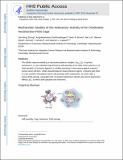| dc.contributor.author | Zheng, Yaorong | |
| dc.contributor.author | Suntharalingam, Kogularamanan | |
| dc.contributor.author | Bruno, Peter Michael | |
| dc.contributor.author | Lin, Wei | |
| dc.contributor.author | Wang, Weixue | |
| dc.contributor.author | Hemann, Michael | |
| dc.contributor.author | Lippard, Stephen J. | |
| dc.date.accessioned | 2018-12-13T15:49:47Z | |
| dc.date.available | 2018-12-13T15:49:47Z | |
| dc.date.issued | 2016-03 | |
| dc.date.submitted | 2016-03 | |
| dc.identifier.issn | 0020-1693 | |
| dc.identifier.uri | http://hdl.handle.net/1721.1/119635 | |
| dc.description.abstract | The cellular response evoked by a hexanuclear platinum complex, Pt6L4(1), is reported. Compound 1, a 3-nm octahedral cage formed by self-assembly of six Pt(II) centers and four 2,4,6-tris(4-pyridyl)-1,3,5-triazine ligands (L), exhibits promising in vitro potency against a panel of human cancer cell lines. Unlike classical platinum-based anticancer agents, 1 interacts with DNA in a non-covalent, intercalative manner and promotes DNA condensation. In cancer cells, 1 induces DNA damage, upregulates p53, its phosphorylated form phospho-p53 and its downstream effector, p21, as well as both apoptosis and senescence. Keywords: Self-assembly; Cage; Anticancer; DNA damage | en_US |
| dc.description.sponsorship | National Cancer Institute (U.S.) (Grant CA034992) | en_US |
| dc.publisher | Elsevier | en_US |
| dc.relation.isversionof | http://dx.doi.org/10.1016/J.ICA.2016.03.021 | en_US |
| dc.rights | Creative Commons Attribution-NonCommercial-NoDerivs License | en_US |
| dc.rights.uri | http://creativecommons.org/licenses/by-nc-nd/4.0/ | en_US |
| dc.source | PMC | en_US |
| dc.title | Mechanistic studies of the anticancer activity of an octahedral hexanuclear Pt(II) cage | en_US |
| dc.type | Article | en_US |
| dc.identifier.citation | Zheng, Yao-Rong et al. “Mechanistic Studies of the Anticancer Activity of an Octahedral Hexanuclear Pt(II) Cage.” Inorganica Chimica Acta 452 (October 2016): 125–129 © 2016 Elsevier B.V. | en_US |
| dc.contributor.department | Massachusetts Institute of Technology. Department of Chemistry | en_US |
| dc.contributor.department | Koch Institute for Integrative Cancer Research at MIT | en_US |
| dc.contributor.mitauthor | Zheng, Yaorong | |
| dc.contributor.mitauthor | Suntharalingam, Kogularamanan | |
| dc.contributor.mitauthor | Bruno, Peter Michael | |
| dc.contributor.mitauthor | Lin, Wei | |
| dc.contributor.mitauthor | Wang, Weixue | |
| dc.contributor.mitauthor | Hemann, Michael | |
| dc.contributor.mitauthor | Lippard, Stephen J. | |
| dc.relation.journal | Inorganica Chimica Acta | en_US |
| dc.eprint.version | Author's final manuscript | en_US |
| dc.type.uri | http://purl.org/eprint/type/JournalArticle | en_US |
| eprint.status | http://purl.org/eprint/status/PeerReviewed | en_US |
| dc.date.updated | 2018-12-04T14:10:51Z | |
| dspace.orderedauthors | Zheng, Yao-Rong; Suntharalingam, Kogularamanan; Bruno, Peter M.; Lin, Wei; Wang, Weixue; Hemann, Michael T.; Lippard, Stephen J. | en_US |
| dspace.embargo.terms | N | en_US |
| dc.identifier.orcid | https://orcid.org/0000-0003-3383-0118 | |
| dc.identifier.orcid | https://orcid.org/0000-0002-2693-4982 | |
| mit.license | PUBLISHER_CC | en_US |
